A Study on Message Frameworks, Alcohol Use, and Intentions
VerifiedAdded on 2021/06/14
|15
|3551
|243
Report
AI Summary
This research report investigates the influence of message frameworks on future alcohol consumption intentions. The study recruited 500 participants through a social media platform, randomly assigning them to different message framework treatment groups. The research aimed to determine if message frames, age, gender, and non-drinking motives significantly predicted future alcohol consumption intentions. The findings revealed that message frames significantly influence alcohol consumption intentions, while gender and age were found to be insignificant predictors. However, non-drinking motives were found to significantly predict future alcohol consumption intentions, and conversely, alcohol future intention was a significant predictor of non-drinking motives. The report includes detailed statistical analysis, including frequency tables, descriptive statistics, ANOVA, and regression analyses, to support the conclusions. Post-hoc tests were conducted to further analyze the differences between the message condition groups.

Running head: PSYCHOLOGICAL RESEARCH
Psychological Research: Alcohol Use
Name
Course Number
Date
Faculty Name
Psychological Research: Alcohol Use
Name
Course Number
Date
Faculty Name
Paraphrase This Document
Need a fresh take? Get an instant paraphrase of this document with our AI Paraphraser
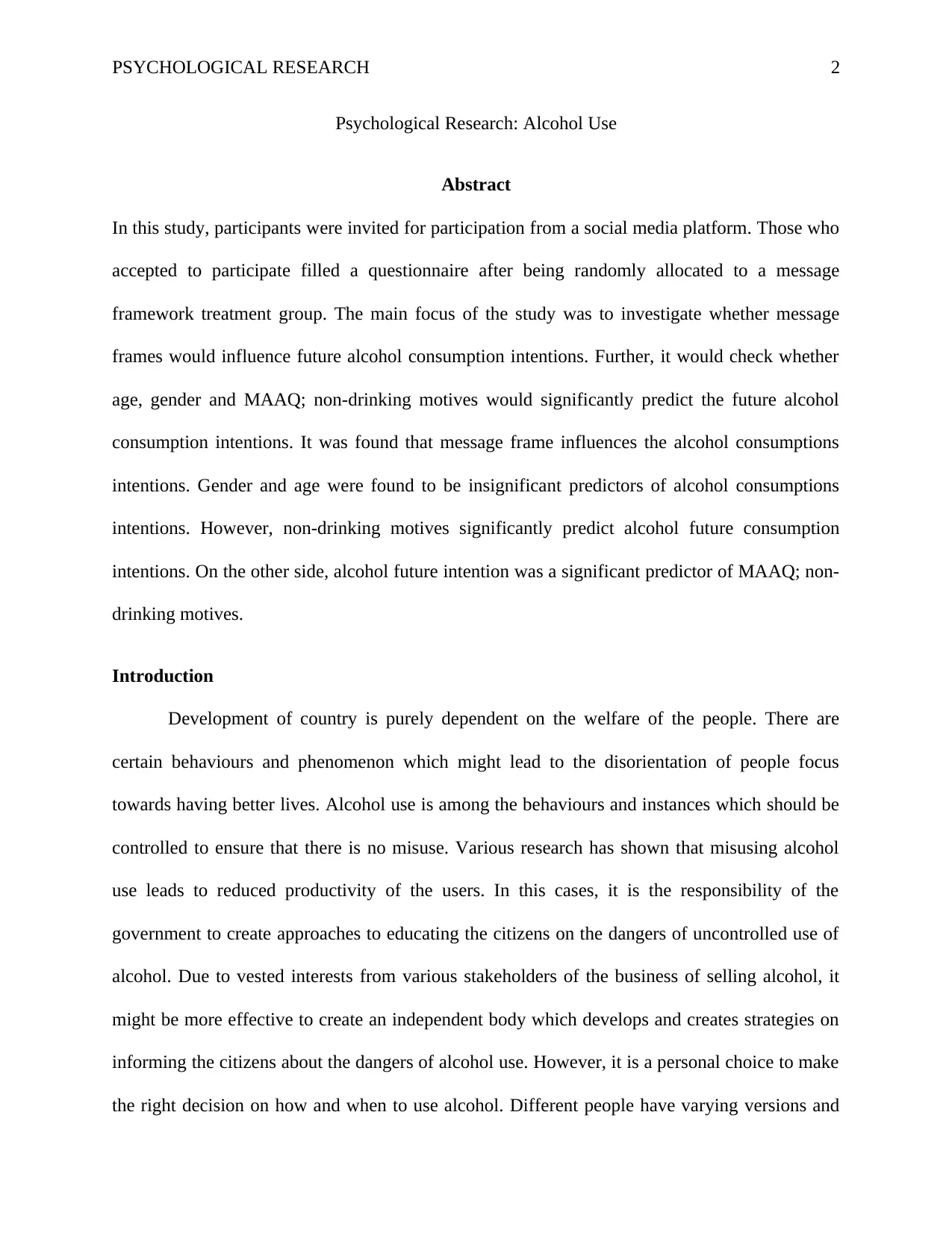
PSYCHOLOGICAL RESEARCH 2
Psychological Research: Alcohol Use
Abstract
In this study, participants were invited for participation from a social media platform. Those who
accepted to participate filled a questionnaire after being randomly allocated to a message
framework treatment group. The main focus of the study was to investigate whether message
frames would influence future alcohol consumption intentions. Further, it would check whether
age, gender and MAAQ; non-drinking motives would significantly predict the future alcohol
consumption intentions. It was found that message frame influences the alcohol consumptions
intentions. Gender and age were found to be insignificant predictors of alcohol consumptions
intentions. However, non-drinking motives significantly predict alcohol future consumption
intentions. On the other side, alcohol future intention was a significant predictor of MAAQ; non-
drinking motives.
Introduction
Development of country is purely dependent on the welfare of the people. There are
certain behaviours and phenomenon which might lead to the disorientation of people focus
towards having better lives. Alcohol use is among the behaviours and instances which should be
controlled to ensure that there is no misuse. Various research has shown that misusing alcohol
use leads to reduced productivity of the users. In this cases, it is the responsibility of the
government to create approaches to educating the citizens on the dangers of uncontrolled use of
alcohol. Due to vested interests from various stakeholders of the business of selling alcohol, it
might be more effective to create an independent body which develops and creates strategies on
informing the citizens about the dangers of alcohol use. However, it is a personal choice to make
the right decision on how and when to use alcohol. Different people have varying versions and
Psychological Research: Alcohol Use
Abstract
In this study, participants were invited for participation from a social media platform. Those who
accepted to participate filled a questionnaire after being randomly allocated to a message
framework treatment group. The main focus of the study was to investigate whether message
frames would influence future alcohol consumption intentions. Further, it would check whether
age, gender and MAAQ; non-drinking motives would significantly predict the future alcohol
consumption intentions. It was found that message frame influences the alcohol consumptions
intentions. Gender and age were found to be insignificant predictors of alcohol consumptions
intentions. However, non-drinking motives significantly predict alcohol future consumption
intentions. On the other side, alcohol future intention was a significant predictor of MAAQ; non-
drinking motives.
Introduction
Development of country is purely dependent on the welfare of the people. There are
certain behaviours and phenomenon which might lead to the disorientation of people focus
towards having better lives. Alcohol use is among the behaviours and instances which should be
controlled to ensure that there is no misuse. Various research has shown that misusing alcohol
use leads to reduced productivity of the users. In this cases, it is the responsibility of the
government to create approaches to educating the citizens on the dangers of uncontrolled use of
alcohol. Due to vested interests from various stakeholders of the business of selling alcohol, it
might be more effective to create an independent body which develops and creates strategies on
informing the citizens about the dangers of alcohol use. However, it is a personal choice to make
the right decision on how and when to use alcohol. Different people have varying versions and
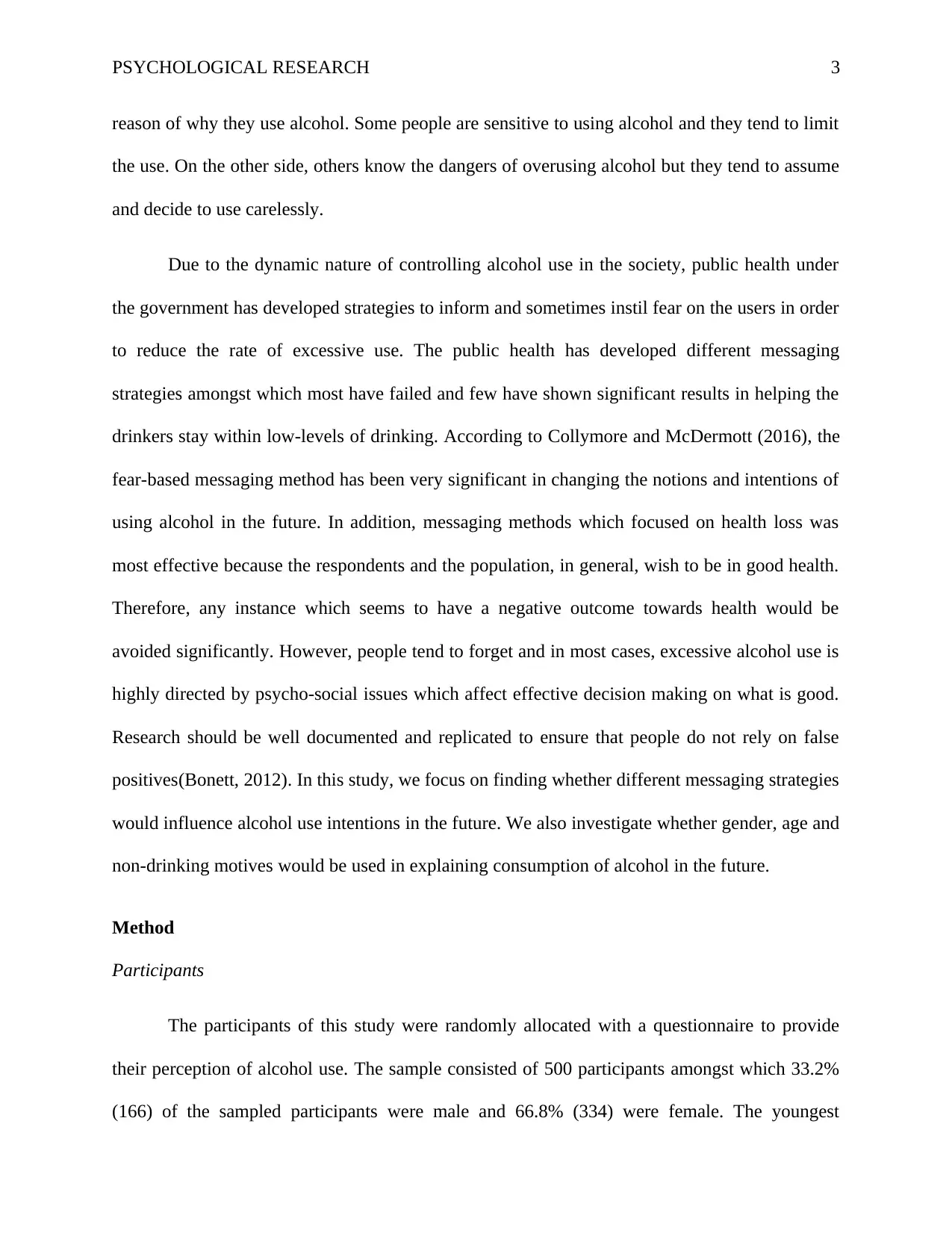
PSYCHOLOGICAL RESEARCH 3
reason of why they use alcohol. Some people are sensitive to using alcohol and they tend to limit
the use. On the other side, others know the dangers of overusing alcohol but they tend to assume
and decide to use carelessly.
Due to the dynamic nature of controlling alcohol use in the society, public health under
the government has developed strategies to inform and sometimes instil fear on the users in order
to reduce the rate of excessive use. The public health has developed different messaging
strategies amongst which most have failed and few have shown significant results in helping the
drinkers stay within low-levels of drinking. According to Collymore and McDermott (2016), the
fear-based messaging method has been very significant in changing the notions and intentions of
using alcohol in the future. In addition, messaging methods which focused on health loss was
most effective because the respondents and the population, in general, wish to be in good health.
Therefore, any instance which seems to have a negative outcome towards health would be
avoided significantly. However, people tend to forget and in most cases, excessive alcohol use is
highly directed by psycho-social issues which affect effective decision making on what is good.
Research should be well documented and replicated to ensure that people do not rely on false
positives(Bonett, 2012). In this study, we focus on finding whether different messaging strategies
would influence alcohol use intentions in the future. We also investigate whether gender, age and
non-drinking motives would be used in explaining consumption of alcohol in the future.
Method
Participants
The participants of this study were randomly allocated with a questionnaire to provide
their perception of alcohol use. The sample consisted of 500 participants amongst which 33.2%
(166) of the sampled participants were male and 66.8% (334) were female. The youngest
reason of why they use alcohol. Some people are sensitive to using alcohol and they tend to limit
the use. On the other side, others know the dangers of overusing alcohol but they tend to assume
and decide to use carelessly.
Due to the dynamic nature of controlling alcohol use in the society, public health under
the government has developed strategies to inform and sometimes instil fear on the users in order
to reduce the rate of excessive use. The public health has developed different messaging
strategies amongst which most have failed and few have shown significant results in helping the
drinkers stay within low-levels of drinking. According to Collymore and McDermott (2016), the
fear-based messaging method has been very significant in changing the notions and intentions of
using alcohol in the future. In addition, messaging methods which focused on health loss was
most effective because the respondents and the population, in general, wish to be in good health.
Therefore, any instance which seems to have a negative outcome towards health would be
avoided significantly. However, people tend to forget and in most cases, excessive alcohol use is
highly directed by psycho-social issues which affect effective decision making on what is good.
Research should be well documented and replicated to ensure that people do not rely on false
positives(Bonett, 2012). In this study, we focus on finding whether different messaging strategies
would influence alcohol use intentions in the future. We also investigate whether gender, age and
non-drinking motives would be used in explaining consumption of alcohol in the future.
Method
Participants
The participants of this study were randomly allocated with a questionnaire to provide
their perception of alcohol use. The sample consisted of 500 participants amongst which 33.2%
(166) of the sampled participants were male and 66.8% (334) were female. The youngest
⊘ This is a preview!⊘
Do you want full access?
Subscribe today to unlock all pages.

Trusted by 1+ million students worldwide
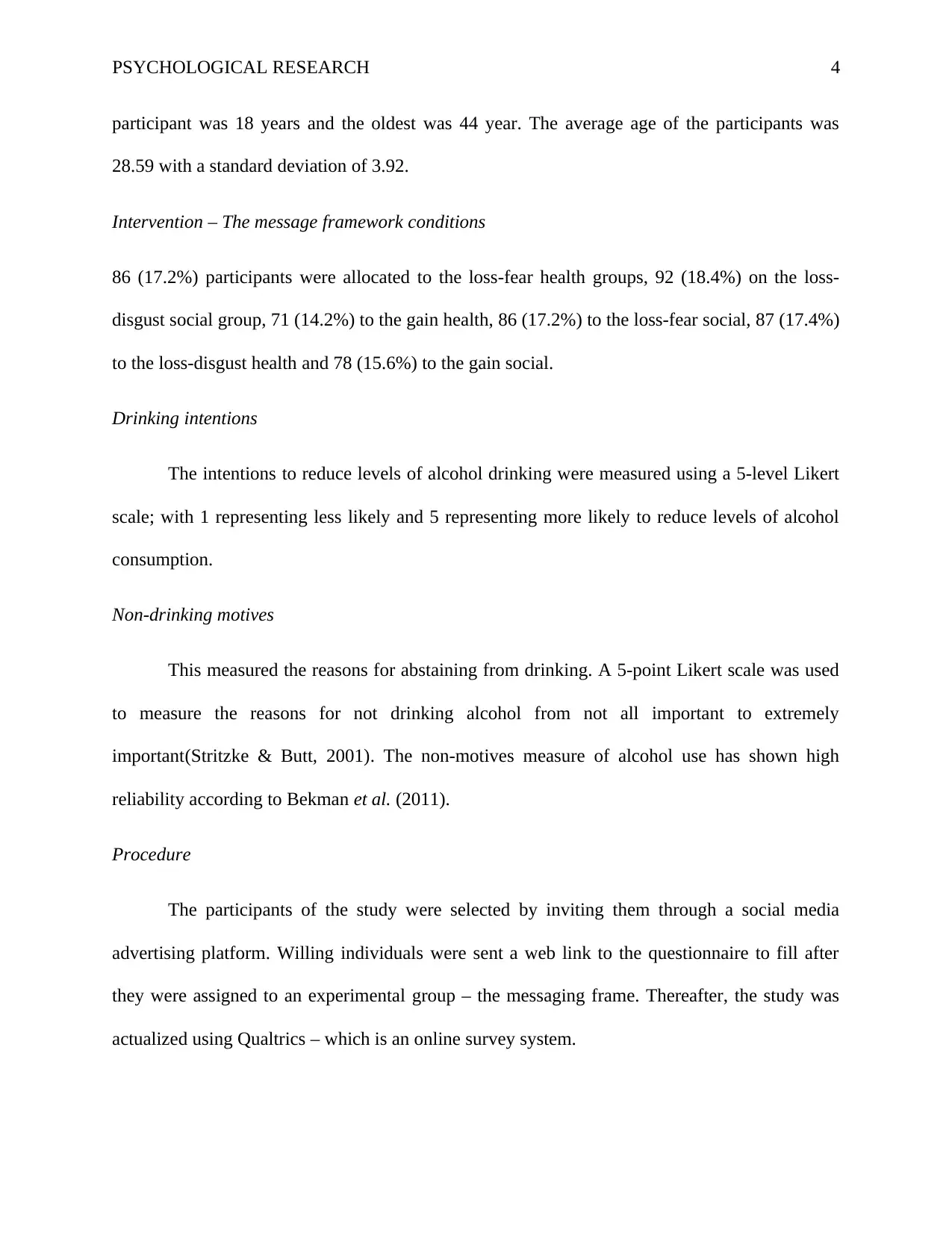
PSYCHOLOGICAL RESEARCH 4
participant was 18 years and the oldest was 44 year. The average age of the participants was
28.59 with a standard deviation of 3.92.
Intervention – The message framework conditions
86 (17.2%) participants were allocated to the loss-fear health groups, 92 (18.4%) on the loss-
disgust social group, 71 (14.2%) to the gain health, 86 (17.2%) to the loss-fear social, 87 (17.4%)
to the loss-disgust health and 78 (15.6%) to the gain social.
Drinking intentions
The intentions to reduce levels of alcohol drinking were measured using a 5-level Likert
scale; with 1 representing less likely and 5 representing more likely to reduce levels of alcohol
consumption.
Non-drinking motives
This measured the reasons for abstaining from drinking. A 5-point Likert scale was used
to measure the reasons for not drinking alcohol from not all important to extremely
important(Stritzke & Butt, 2001). The non-motives measure of alcohol use has shown high
reliability according to Bekman et al. (2011).
Procedure
The participants of the study were selected by inviting them through a social media
advertising platform. Willing individuals were sent a web link to the questionnaire to fill after
they were assigned to an experimental group – the messaging frame. Thereafter, the study was
actualized using Qualtrics – which is an online survey system.
participant was 18 years and the oldest was 44 year. The average age of the participants was
28.59 with a standard deviation of 3.92.
Intervention – The message framework conditions
86 (17.2%) participants were allocated to the loss-fear health groups, 92 (18.4%) on the loss-
disgust social group, 71 (14.2%) to the gain health, 86 (17.2%) to the loss-fear social, 87 (17.4%)
to the loss-disgust health and 78 (15.6%) to the gain social.
Drinking intentions
The intentions to reduce levels of alcohol drinking were measured using a 5-level Likert
scale; with 1 representing less likely and 5 representing more likely to reduce levels of alcohol
consumption.
Non-drinking motives
This measured the reasons for abstaining from drinking. A 5-point Likert scale was used
to measure the reasons for not drinking alcohol from not all important to extremely
important(Stritzke & Butt, 2001). The non-motives measure of alcohol use has shown high
reliability according to Bekman et al. (2011).
Procedure
The participants of the study were selected by inviting them through a social media
advertising platform. Willing individuals were sent a web link to the questionnaire to fill after
they were assigned to an experimental group – the messaging frame. Thereafter, the study was
actualized using Qualtrics – which is an online survey system.
Paraphrase This Document
Need a fresh take? Get an instant paraphrase of this document with our AI Paraphraser
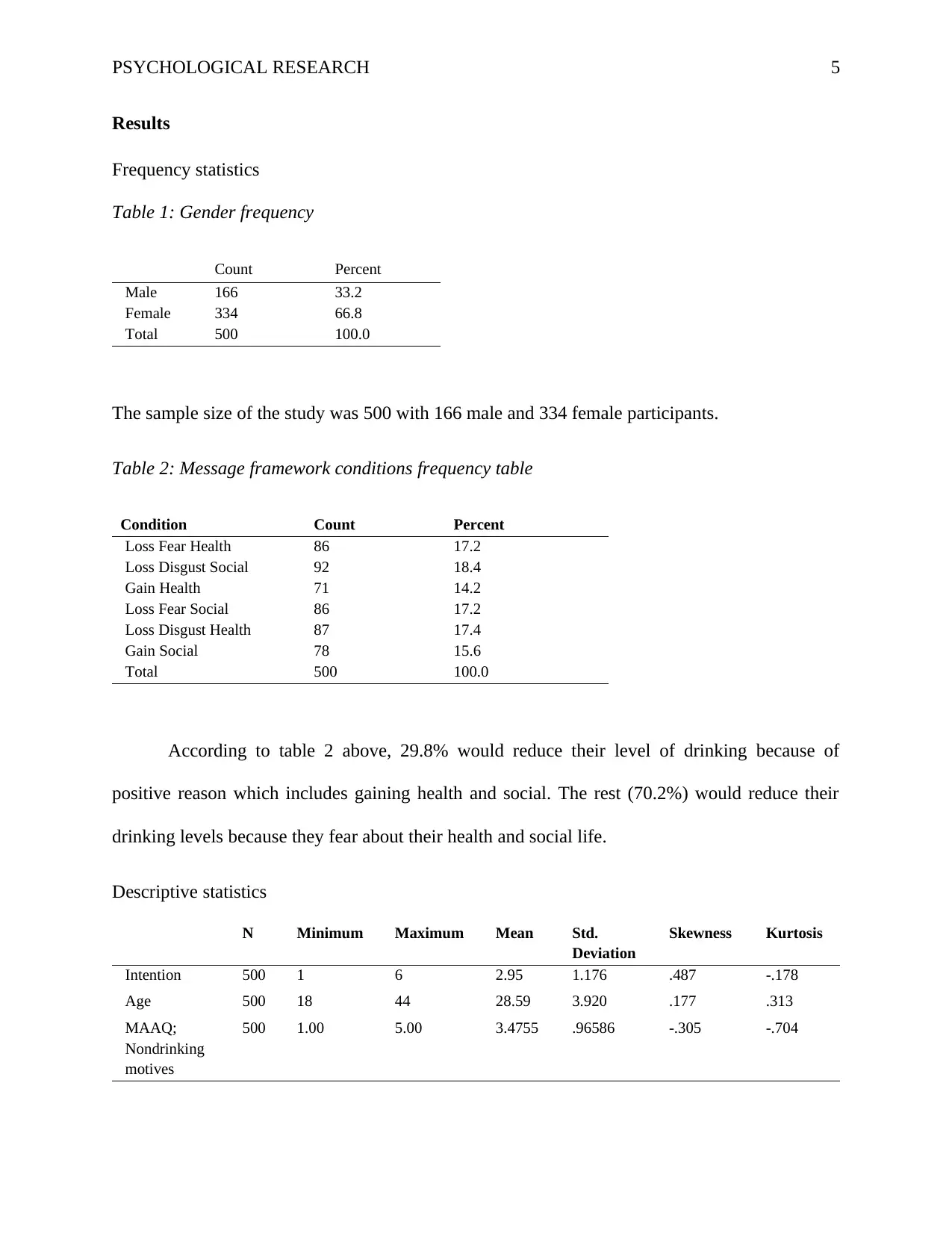
PSYCHOLOGICAL RESEARCH 5
Results
Frequency statistics
Table 1: Gender frequency
Count Percent
Male 166 33.2
Female 334 66.8
Total 500 100.0
The sample size of the study was 500 with 166 male and 334 female participants.
Table 2: Message framework conditions frequency table
Condition Count Percent
Loss Fear Health 86 17.2
Loss Disgust Social 92 18.4
Gain Health 71 14.2
Loss Fear Social 86 17.2
Loss Disgust Health 87 17.4
Gain Social 78 15.6
Total 500 100.0
According to table 2 above, 29.8% would reduce their level of drinking because of
positive reason which includes gaining health and social. The rest (70.2%) would reduce their
drinking levels because they fear about their health and social life.
Descriptive statistics
N Minimum Maximum Mean Std.
Deviation
Skewness Kurtosis
Intention 500 1 6 2.95 1.176 .487 -.178
Age 500 18 44 28.59 3.920 .177 .313
MAAQ;
Nondrinking
motives
500 1.00 5.00 3.4755 .96586 -.305 -.704
Results
Frequency statistics
Table 1: Gender frequency
Count Percent
Male 166 33.2
Female 334 66.8
Total 500 100.0
The sample size of the study was 500 with 166 male and 334 female participants.
Table 2: Message framework conditions frequency table
Condition Count Percent
Loss Fear Health 86 17.2
Loss Disgust Social 92 18.4
Gain Health 71 14.2
Loss Fear Social 86 17.2
Loss Disgust Health 87 17.4
Gain Social 78 15.6
Total 500 100.0
According to table 2 above, 29.8% would reduce their level of drinking because of
positive reason which includes gaining health and social. The rest (70.2%) would reduce their
drinking levels because they fear about their health and social life.
Descriptive statistics
N Minimum Maximum Mean Std.
Deviation
Skewness Kurtosis
Intention 500 1 6 2.95 1.176 .487 -.178
Age 500 18 44 28.59 3.920 .177 .313
MAAQ;
Nondrinking
motives
500 1.00 5.00 3.4755 .96586 -.305 -.704
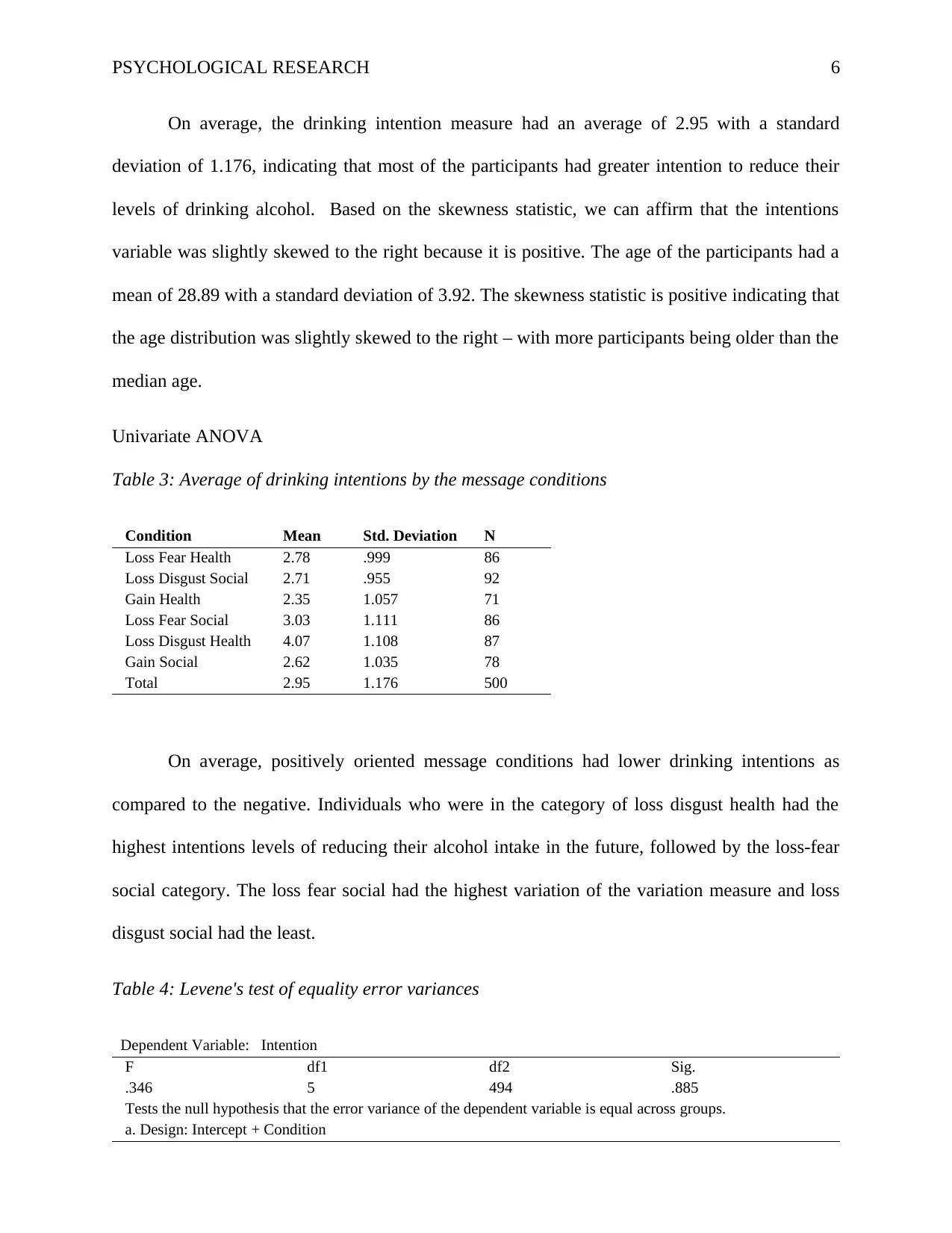
PSYCHOLOGICAL RESEARCH 6
On average, the drinking intention measure had an average of 2.95 with a standard
deviation of 1.176, indicating that most of the participants had greater intention to reduce their
levels of drinking alcohol. Based on the skewness statistic, we can affirm that the intentions
variable was slightly skewed to the right because it is positive. The age of the participants had a
mean of 28.89 with a standard deviation of 3.92. The skewness statistic is positive indicating that
the age distribution was slightly skewed to the right – with more participants being older than the
median age.
Univariate ANOVA
Table 3: Average of drinking intentions by the message conditions
Condition Mean Std. Deviation N
Loss Fear Health 2.78 .999 86
Loss Disgust Social 2.71 .955 92
Gain Health 2.35 1.057 71
Loss Fear Social 3.03 1.111 86
Loss Disgust Health 4.07 1.108 87
Gain Social 2.62 1.035 78
Total 2.95 1.176 500
On average, positively oriented message conditions had lower drinking intentions as
compared to the negative. Individuals who were in the category of loss disgust health had the
highest intentions levels of reducing their alcohol intake in the future, followed by the loss-fear
social category. The loss fear social had the highest variation of the variation measure and loss
disgust social had the least.
Table 4: Levene's test of equality error variances
Dependent Variable: Intention
F df1 df2 Sig.
.346 5 494 .885
Tests the null hypothesis that the error variance of the dependent variable is equal across groups.
a. Design: Intercept + Condition
On average, the drinking intention measure had an average of 2.95 with a standard
deviation of 1.176, indicating that most of the participants had greater intention to reduce their
levels of drinking alcohol. Based on the skewness statistic, we can affirm that the intentions
variable was slightly skewed to the right because it is positive. The age of the participants had a
mean of 28.89 with a standard deviation of 3.92. The skewness statistic is positive indicating that
the age distribution was slightly skewed to the right – with more participants being older than the
median age.
Univariate ANOVA
Table 3: Average of drinking intentions by the message conditions
Condition Mean Std. Deviation N
Loss Fear Health 2.78 .999 86
Loss Disgust Social 2.71 .955 92
Gain Health 2.35 1.057 71
Loss Fear Social 3.03 1.111 86
Loss Disgust Health 4.07 1.108 87
Gain Social 2.62 1.035 78
Total 2.95 1.176 500
On average, positively oriented message conditions had lower drinking intentions as
compared to the negative. Individuals who were in the category of loss disgust health had the
highest intentions levels of reducing their alcohol intake in the future, followed by the loss-fear
social category. The loss fear social had the highest variation of the variation measure and loss
disgust social had the least.
Table 4: Levene's test of equality error variances
Dependent Variable: Intention
F df1 df2 Sig.
.346 5 494 .885
Tests the null hypothesis that the error variance of the dependent variable is equal across groups.
a. Design: Intercept + Condition
⊘ This is a preview!⊘
Do you want full access?
Subscribe today to unlock all pages.

Trusted by 1+ million students worldwide
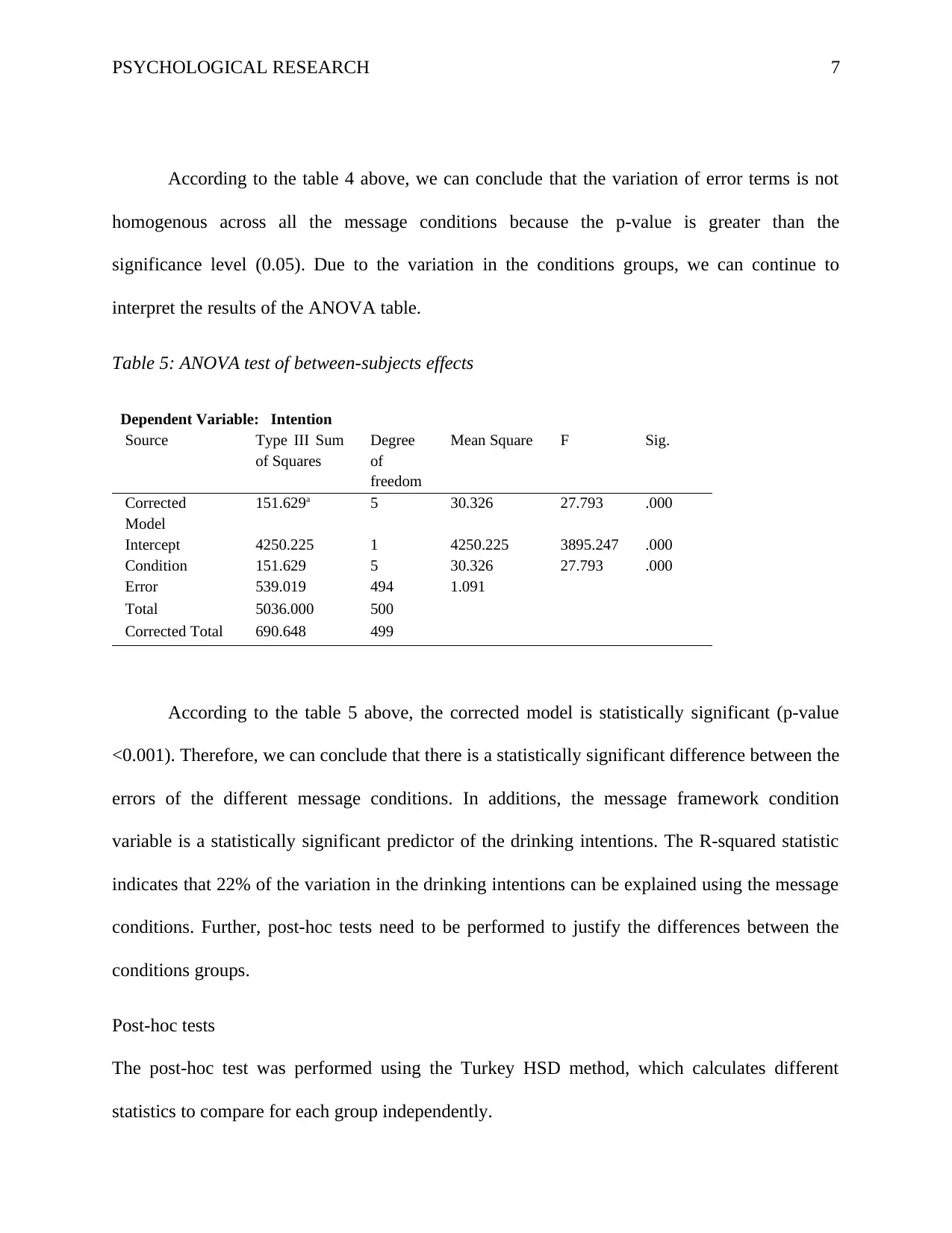
PSYCHOLOGICAL RESEARCH 7
According to the table 4 above, we can conclude that the variation of error terms is not
homogenous across all the message conditions because the p-value is greater than the
significance level (0.05). Due to the variation in the conditions groups, we can continue to
interpret the results of the ANOVA table.
Table 5: ANOVA test of between-subjects effects
Dependent Variable: Intention
Source Type III Sum
of Squares
Degree
of
freedom
Mean Square F Sig.
Corrected
Model
151.629a 5 30.326 27.793 .000
Intercept 4250.225 1 4250.225 3895.247 .000
Condition 151.629 5 30.326 27.793 .000
Error 539.019 494 1.091
Total 5036.000 500
Corrected Total 690.648 499
According to the table 5 above, the corrected model is statistically significant (p-value
<0.001). Therefore, we can conclude that there is a statistically significant difference between the
errors of the different message conditions. In additions, the message framework condition
variable is a statistically significant predictor of the drinking intentions. The R-squared statistic
indicates that 22% of the variation in the drinking intentions can be explained using the message
conditions. Further, post-hoc tests need to be performed to justify the differences between the
conditions groups.
Post-hoc tests
The post-hoc test was performed using the Turkey HSD method, which calculates different
statistics to compare for each group independently.
According to the table 4 above, we can conclude that the variation of error terms is not
homogenous across all the message conditions because the p-value is greater than the
significance level (0.05). Due to the variation in the conditions groups, we can continue to
interpret the results of the ANOVA table.
Table 5: ANOVA test of between-subjects effects
Dependent Variable: Intention
Source Type III Sum
of Squares
Degree
of
freedom
Mean Square F Sig.
Corrected
Model
151.629a 5 30.326 27.793 .000
Intercept 4250.225 1 4250.225 3895.247 .000
Condition 151.629 5 30.326 27.793 .000
Error 539.019 494 1.091
Total 5036.000 500
Corrected Total 690.648 499
According to the table 5 above, the corrected model is statistically significant (p-value
<0.001). Therefore, we can conclude that there is a statistically significant difference between the
errors of the different message conditions. In additions, the message framework condition
variable is a statistically significant predictor of the drinking intentions. The R-squared statistic
indicates that 22% of the variation in the drinking intentions can be explained using the message
conditions. Further, post-hoc tests need to be performed to justify the differences between the
conditions groups.
Post-hoc tests
The post-hoc test was performed using the Turkey HSD method, which calculates different
statistics to compare for each group independently.
Paraphrase This Document
Need a fresh take? Get an instant paraphrase of this document with our AI Paraphraser

PSYCHOLOGICAL RESEARCH 8
Table 6: Turkey HSD test
(I) Condition (J) Condition Mean
Difference (I-J) Std. Error Sig.
Loss Fear Health Loss Disgust Social .07 .157 .997
Gain Health .43 .167 .112
Loss Fear Social -.26 .159 .595
Loss Disgust Health -1.29* .159 .000
Gain Social .16 .163 .917
Loss Disgust Social Loss Fear Health -.07 .157 .997
Gain Health .35 .165 .265
Loss Fear Social -.33 .157 .291
Loss Disgust Health -1.36* .156 .000
Gain Social .09 .161 .993
Gain Health Loss Fear Health -.43 .167 .112
Loss Disgust Social -.35 .165 .265
Loss Fear Social -.68* .167 .001
Loss Disgust Health -1.72* .167 .000
Gain Social -.26 .171 .641
Loss Fear Social Loss Fear Health .26 .159 .595
Loss Disgust Social .33 .157 .291
Gain Health .68* .167 .001
Loss Disgust Health -1.03* .159 .000
Gain Social .42 .163 .107
Loss Disgust Health Loss Fear Health 1.29* .159 .000
Loss Disgust Social 1.36* .156 .000
Gain Health 1.72* .167 .000
Loss Fear Social 1.03* .159 .000
Gain Social 1.45* .163 .000
Gain Social Loss Fear Health -.16 .163 .917
Loss Disgust Social -.09 .161 .993
Gain Health .26 .171 .641
Loss Fear Social -.42 .163 .107
Loss Disgust Health -1.45* .163 .000
According to table 6 above, comparing loss-disgust health with all other message conditions
were statistically significant with p-values less than 0.001. In additions, the intentions average of
gain health and loss-fear social were significantly different at 5% level of significance.
Table 6: Turkey HSD test
(I) Condition (J) Condition Mean
Difference (I-J) Std. Error Sig.
Loss Fear Health Loss Disgust Social .07 .157 .997
Gain Health .43 .167 .112
Loss Fear Social -.26 .159 .595
Loss Disgust Health -1.29* .159 .000
Gain Social .16 .163 .917
Loss Disgust Social Loss Fear Health -.07 .157 .997
Gain Health .35 .165 .265
Loss Fear Social -.33 .157 .291
Loss Disgust Health -1.36* .156 .000
Gain Social .09 .161 .993
Gain Health Loss Fear Health -.43 .167 .112
Loss Disgust Social -.35 .165 .265
Loss Fear Social -.68* .167 .001
Loss Disgust Health -1.72* .167 .000
Gain Social -.26 .171 .641
Loss Fear Social Loss Fear Health .26 .159 .595
Loss Disgust Social .33 .157 .291
Gain Health .68* .167 .001
Loss Disgust Health -1.03* .159 .000
Gain Social .42 .163 .107
Loss Disgust Health Loss Fear Health 1.29* .159 .000
Loss Disgust Social 1.36* .156 .000
Gain Health 1.72* .167 .000
Loss Fear Social 1.03* .159 .000
Gain Social 1.45* .163 .000
Gain Social Loss Fear Health -.16 .163 .917
Loss Disgust Social -.09 .161 .993
Gain Health .26 .171 .641
Loss Fear Social -.42 .163 .107
Loss Disgust Health -1.45* .163 .000
According to table 6 above, comparing loss-disgust health with all other message conditions
were statistically significant with p-values less than 0.001. In additions, the intentions average of
gain health and loss-fear social were significantly different at 5% level of significance.
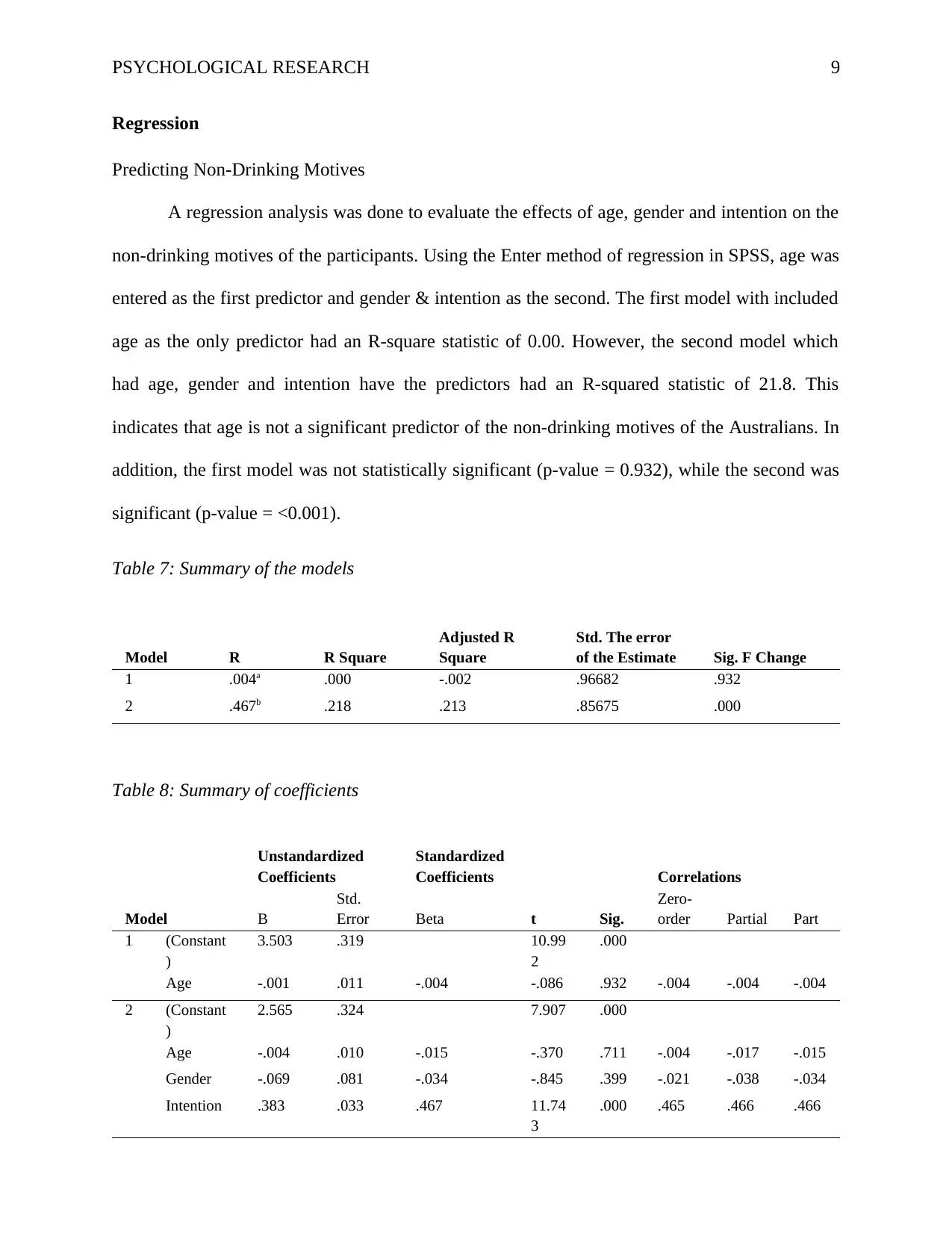
PSYCHOLOGICAL RESEARCH 9
Regression
Predicting Non-Drinking Motives
A regression analysis was done to evaluate the effects of age, gender and intention on the
non-drinking motives of the participants. Using the Enter method of regression in SPSS, age was
entered as the first predictor and gender & intention as the second. The first model with included
age as the only predictor had an R-square statistic of 0.00. However, the second model which
had age, gender and intention have the predictors had an R-squared statistic of 21.8. This
indicates that age is not a significant predictor of the non-drinking motives of the Australians. In
addition, the first model was not statistically significant (p-value = 0.932), while the second was
significant (p-value = <0.001).
Table 7: Summary of the models
Model R R Square
Adjusted R
Square
Std. The error
of the Estimate Sig. F Change
1 .004a .000 -.002 .96682 .932
2 .467b .218 .213 .85675 .000
Table 8: Summary of coefficients
Model
Unstandardized
Coefficients
Standardized
Coefficients
t Sig.
Correlations
B
Std.
Error Beta
Zero-
order Partial Part
1 (Constant
)
3.503 .319 10.99
2
.000
Age -.001 .011 -.004 -.086 .932 -.004 -.004 -.004
2 (Constant
)
2.565 .324 7.907 .000
Age -.004 .010 -.015 -.370 .711 -.004 -.017 -.015
Gender -.069 .081 -.034 -.845 .399 -.021 -.038 -.034
Intention .383 .033 .467 11.74
3
.000 .465 .466 .466
Regression
Predicting Non-Drinking Motives
A regression analysis was done to evaluate the effects of age, gender and intention on the
non-drinking motives of the participants. Using the Enter method of regression in SPSS, age was
entered as the first predictor and gender & intention as the second. The first model with included
age as the only predictor had an R-square statistic of 0.00. However, the second model which
had age, gender and intention have the predictors had an R-squared statistic of 21.8. This
indicates that age is not a significant predictor of the non-drinking motives of the Australians. In
addition, the first model was not statistically significant (p-value = 0.932), while the second was
significant (p-value = <0.001).
Table 7: Summary of the models
Model R R Square
Adjusted R
Square
Std. The error
of the Estimate Sig. F Change
1 .004a .000 -.002 .96682 .932
2 .467b .218 .213 .85675 .000
Table 8: Summary of coefficients
Model
Unstandardized
Coefficients
Standardized
Coefficients
t Sig.
Correlations
B
Std.
Error Beta
Zero-
order Partial Part
1 (Constant
)
3.503 .319 10.99
2
.000
Age -.001 .011 -.004 -.086 .932 -.004 -.004 -.004
2 (Constant
)
2.565 .324 7.907 .000
Age -.004 .010 -.015 -.370 .711 -.004 -.017 -.015
Gender -.069 .081 -.034 -.845 .399 -.021 -.038 -.034
Intention .383 .033 .467 11.74
3
.000 .465 .466 .466
⊘ This is a preview!⊘
Do you want full access?
Subscribe today to unlock all pages.

Trusted by 1+ million students worldwide
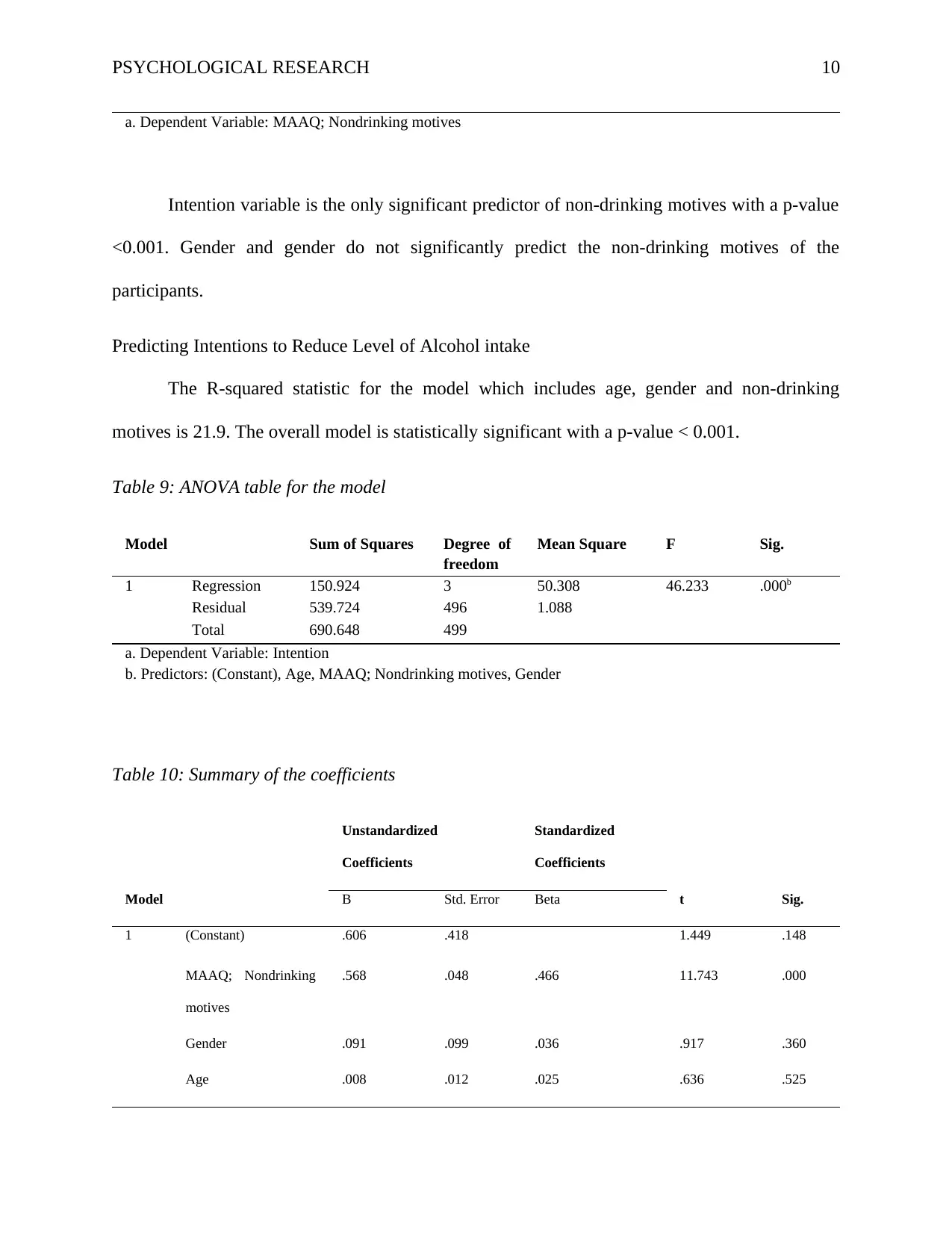
PSYCHOLOGICAL RESEARCH 10
a. Dependent Variable: MAAQ; Nondrinking motives
Intention variable is the only significant predictor of non-drinking motives with a p-value
<0.001. Gender and gender do not significantly predict the non-drinking motives of the
participants.
Predicting Intentions to Reduce Level of Alcohol intake
The R-squared statistic for the model which includes age, gender and non-drinking
motives is 21.9. The overall model is statistically significant with a p-value < 0.001.
Table 9: ANOVA table for the model
Model Sum of Squares Degree of
freedom
Mean Square F Sig.
1 Regression 150.924 3 50.308 46.233 .000b
Residual 539.724 496 1.088
Total 690.648 499
a. Dependent Variable: Intention
b. Predictors: (Constant), Age, MAAQ; Nondrinking motives, Gender
Table 10: Summary of the coefficients
Model
Unstandardized
Coefficients
Standardized
Coefficients
t Sig.B Std. Error Beta
1 (Constant) .606 .418 1.449 .148
MAAQ; Nondrinking
motives
.568 .048 .466 11.743 .000
Gender .091 .099 .036 .917 .360
Age .008 .012 .025 .636 .525
a. Dependent Variable: MAAQ; Nondrinking motives
Intention variable is the only significant predictor of non-drinking motives with a p-value
<0.001. Gender and gender do not significantly predict the non-drinking motives of the
participants.
Predicting Intentions to Reduce Level of Alcohol intake
The R-squared statistic for the model which includes age, gender and non-drinking
motives is 21.9. The overall model is statistically significant with a p-value < 0.001.
Table 9: ANOVA table for the model
Model Sum of Squares Degree of
freedom
Mean Square F Sig.
1 Regression 150.924 3 50.308 46.233 .000b
Residual 539.724 496 1.088
Total 690.648 499
a. Dependent Variable: Intention
b. Predictors: (Constant), Age, MAAQ; Nondrinking motives, Gender
Table 10: Summary of the coefficients
Model
Unstandardized
Coefficients
Standardized
Coefficients
t Sig.B Std. Error Beta
1 (Constant) .606 .418 1.449 .148
MAAQ; Nondrinking
motives
.568 .048 .466 11.743 .000
Gender .091 .099 .036 .917 .360
Age .008 .012 .025 .636 .525
Paraphrase This Document
Need a fresh take? Get an instant paraphrase of this document with our AI Paraphraser
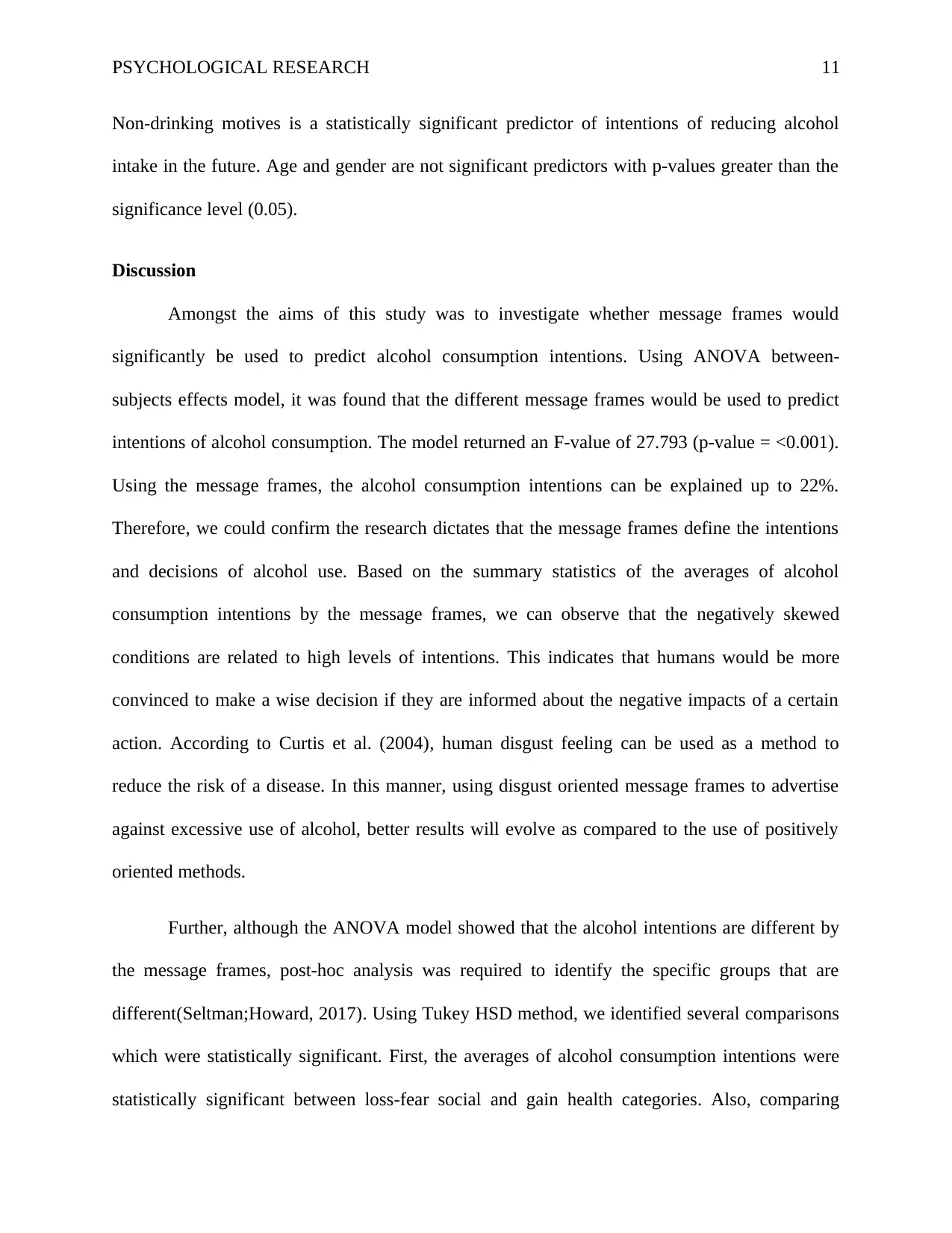
PSYCHOLOGICAL RESEARCH 11
Non-drinking motives is a statistically significant predictor of intentions of reducing alcohol
intake in the future. Age and gender are not significant predictors with p-values greater than the
significance level (0.05).
Discussion
Amongst the aims of this study was to investigate whether message frames would
significantly be used to predict alcohol consumption intentions. Using ANOVA between-
subjects effects model, it was found that the different message frames would be used to predict
intentions of alcohol consumption. The model returned an F-value of 27.793 (p-value = <0.001).
Using the message frames, the alcohol consumption intentions can be explained up to 22%.
Therefore, we could confirm the research dictates that the message frames define the intentions
and decisions of alcohol use. Based on the summary statistics of the averages of alcohol
consumption intentions by the message frames, we can observe that the negatively skewed
conditions are related to high levels of intentions. This indicates that humans would be more
convinced to make a wise decision if they are informed about the negative impacts of a certain
action. According to Curtis et al. (2004), human disgust feeling can be used as a method to
reduce the risk of a disease. In this manner, using disgust oriented message frames to advertise
against excessive use of alcohol, better results will evolve as compared to the use of positively
oriented methods.
Further, although the ANOVA model showed that the alcohol intentions are different by
the message frames, post-hoc analysis was required to identify the specific groups that are
different(Seltman;Howard, 2017). Using Tukey HSD method, we identified several comparisons
which were statistically significant. First, the averages of alcohol consumption intentions were
statistically significant between loss-fear social and gain health categories. Also, comparing
Non-drinking motives is a statistically significant predictor of intentions of reducing alcohol
intake in the future. Age and gender are not significant predictors with p-values greater than the
significance level (0.05).
Discussion
Amongst the aims of this study was to investigate whether message frames would
significantly be used to predict alcohol consumption intentions. Using ANOVA between-
subjects effects model, it was found that the different message frames would be used to predict
intentions of alcohol consumption. The model returned an F-value of 27.793 (p-value = <0.001).
Using the message frames, the alcohol consumption intentions can be explained up to 22%.
Therefore, we could confirm the research dictates that the message frames define the intentions
and decisions of alcohol use. Based on the summary statistics of the averages of alcohol
consumption intentions by the message frames, we can observe that the negatively skewed
conditions are related to high levels of intentions. This indicates that humans would be more
convinced to make a wise decision if they are informed about the negative impacts of a certain
action. According to Curtis et al. (2004), human disgust feeling can be used as a method to
reduce the risk of a disease. In this manner, using disgust oriented message frames to advertise
against excessive use of alcohol, better results will evolve as compared to the use of positively
oriented methods.
Further, although the ANOVA model showed that the alcohol intentions are different by
the message frames, post-hoc analysis was required to identify the specific groups that are
different(Seltman;Howard, 2017). Using Tukey HSD method, we identified several comparisons
which were statistically significant. First, the averages of alcohol consumption intentions were
statistically significant between loss-fear social and gain health categories. Also, comparing
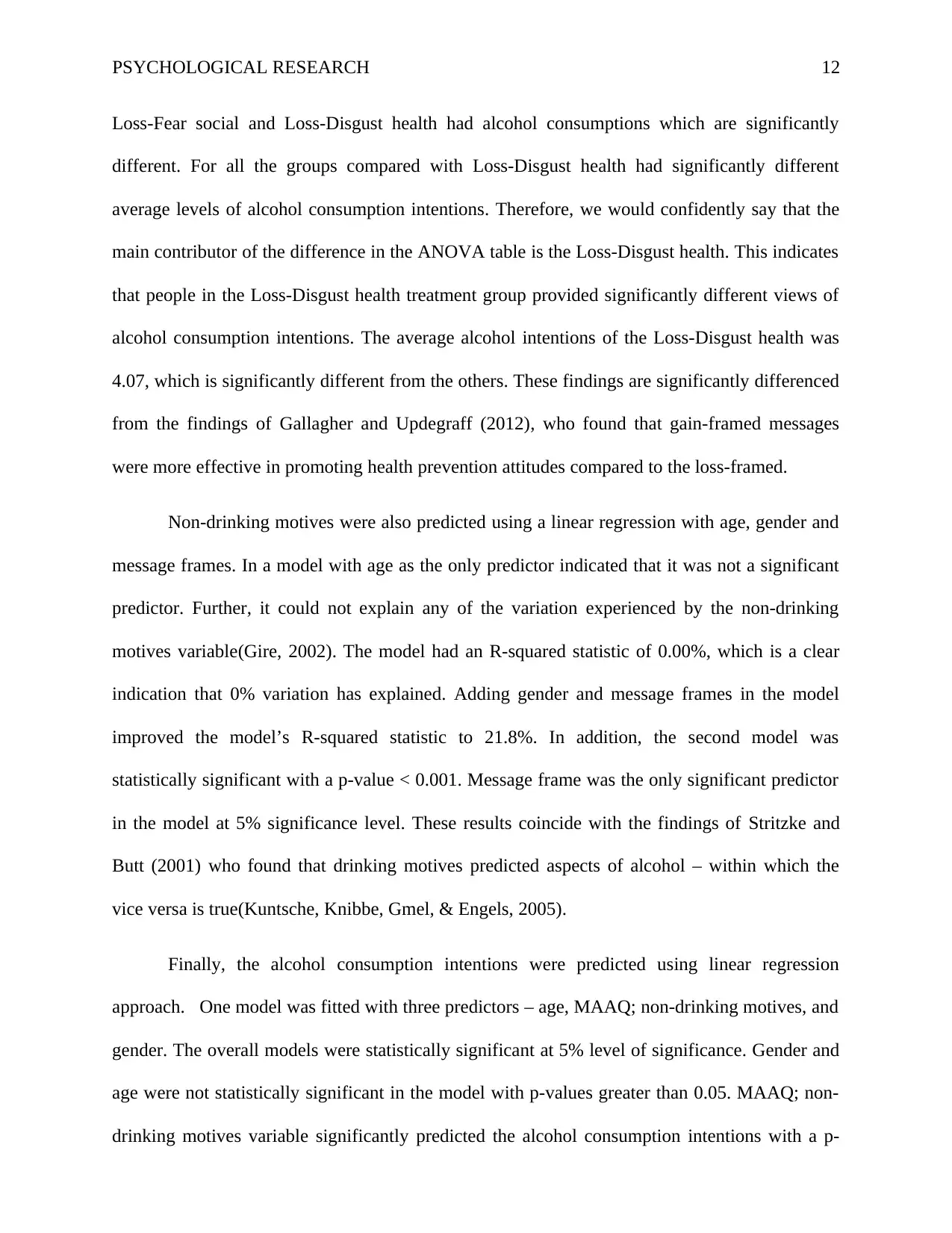
PSYCHOLOGICAL RESEARCH 12
Loss-Fear social and Loss-Disgust health had alcohol consumptions which are significantly
different. For all the groups compared with Loss-Disgust health had significantly different
average levels of alcohol consumption intentions. Therefore, we would confidently say that the
main contributor of the difference in the ANOVA table is the Loss-Disgust health. This indicates
that people in the Loss-Disgust health treatment group provided significantly different views of
alcohol consumption intentions. The average alcohol intentions of the Loss-Disgust health was
4.07, which is significantly different from the others. These findings are significantly differenced
from the findings of Gallagher and Updegraff (2012), who found that gain-framed messages
were more effective in promoting health prevention attitudes compared to the loss-framed.
Non-drinking motives were also predicted using a linear regression with age, gender and
message frames. In a model with age as the only predictor indicated that it was not a significant
predictor. Further, it could not explain any of the variation experienced by the non-drinking
motives variable(Gire, 2002). The model had an R-squared statistic of 0.00%, which is a clear
indication that 0% variation has explained. Adding gender and message frames in the model
improved the model’s R-squared statistic to 21.8%. In addition, the second model was
statistically significant with a p-value < 0.001. Message frame was the only significant predictor
in the model at 5% significance level. These results coincide with the findings of Stritzke and
Butt (2001) who found that drinking motives predicted aspects of alcohol – within which the
vice versa is true(Kuntsche, Knibbe, Gmel, & Engels, 2005).
Finally, the alcohol consumption intentions were predicted using linear regression
approach. One model was fitted with three predictors – age, MAAQ; non-drinking motives, and
gender. The overall models were statistically significant at 5% level of significance. Gender and
age were not statistically significant in the model with p-values greater than 0.05. MAAQ; non-
drinking motives variable significantly predicted the alcohol consumption intentions with a p-
Loss-Fear social and Loss-Disgust health had alcohol consumptions which are significantly
different. For all the groups compared with Loss-Disgust health had significantly different
average levels of alcohol consumption intentions. Therefore, we would confidently say that the
main contributor of the difference in the ANOVA table is the Loss-Disgust health. This indicates
that people in the Loss-Disgust health treatment group provided significantly different views of
alcohol consumption intentions. The average alcohol intentions of the Loss-Disgust health was
4.07, which is significantly different from the others. These findings are significantly differenced
from the findings of Gallagher and Updegraff (2012), who found that gain-framed messages
were more effective in promoting health prevention attitudes compared to the loss-framed.
Non-drinking motives were also predicted using a linear regression with age, gender and
message frames. In a model with age as the only predictor indicated that it was not a significant
predictor. Further, it could not explain any of the variation experienced by the non-drinking
motives variable(Gire, 2002). The model had an R-squared statistic of 0.00%, which is a clear
indication that 0% variation has explained. Adding gender and message frames in the model
improved the model’s R-squared statistic to 21.8%. In addition, the second model was
statistically significant with a p-value < 0.001. Message frame was the only significant predictor
in the model at 5% significance level. These results coincide with the findings of Stritzke and
Butt (2001) who found that drinking motives predicted aspects of alcohol – within which the
vice versa is true(Kuntsche, Knibbe, Gmel, & Engels, 2005).
Finally, the alcohol consumption intentions were predicted using linear regression
approach. One model was fitted with three predictors – age, MAAQ; non-drinking motives, and
gender. The overall models were statistically significant at 5% level of significance. Gender and
age were not statistically significant in the model with p-values greater than 0.05. MAAQ; non-
drinking motives variable significantly predicted the alcohol consumption intentions with a p-
⊘ This is a preview!⊘
Do you want full access?
Subscribe today to unlock all pages.

Trusted by 1+ million students worldwide
1 out of 15
Related Documents
Your All-in-One AI-Powered Toolkit for Academic Success.
+13062052269
info@desklib.com
Available 24*7 on WhatsApp / Email
![[object Object]](/_next/static/media/star-bottom.7253800d.svg)
Unlock your academic potential
Copyright © 2020–2025 A2Z Services. All Rights Reserved. Developed and managed by ZUCOL.



